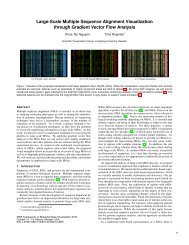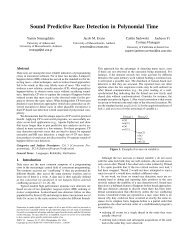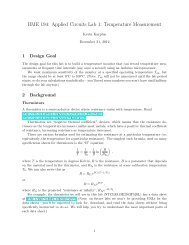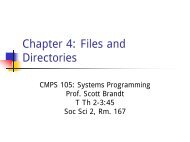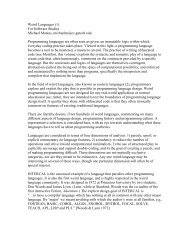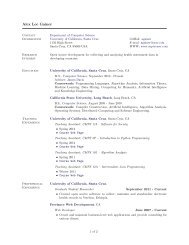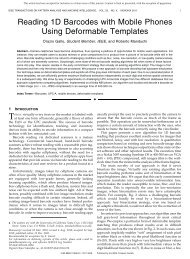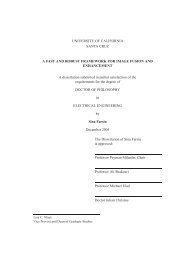Amoeba — A Distributed Operating System for the 1990s - CiteSeerX
Amoeba — A Distributed Operating System for the 1990s - CiteSeerX
Amoeba — A Distributed Operating System for the 1990s - CiteSeerX
You also want an ePaper? Increase the reach of your titles
YUMPU automatically turns print PDFs into web optimized ePapers that Google loves.
Server port Object number Rights field Check field<br />
48 24 8 48 Bits<br />
Figure 2: Structure of a capability. The service port identifies <strong>the</strong> service that manages <strong>the</strong> object.<br />
The object number specifies which object (e.g., which file). The rights tell which operations<br />
are permitted. The check field provides cryptographic protection to keep users from<br />
tampering with <strong>the</strong> o<strong>the</strong>r fields.<br />
2.2 The <strong>Amoeba</strong> Software Architecture<br />
<strong>Amoeba</strong> is an object-based system using clients and servers. Client processes use remote procedure<br />
calls to send requests to server processes <strong>for</strong> carrying out operations on objects. Each<br />
object is both identified and protected by a capability, as shown in Figure 2. Capabilities have<br />
<strong>the</strong> set of operations that <strong>the</strong> holder may carry out on <strong>the</strong> object coded into <strong>the</strong>m and <strong>the</strong>y contain<br />
enough redundancy and cryptographic protection to make it infeasible to guess an object’s<br />
capability. Thus, keeping capabilities secret by embedding <strong>the</strong>m in a huge address space is <strong>the</strong><br />
key to protection in <strong>Amoeba</strong>. Due to <strong>the</strong> cryptographic protection, capabilities are managed<br />
outside <strong>the</strong> kernel, by user processes <strong>the</strong>mselves.<br />
Objects are implemented by server processes that manage <strong>the</strong>m. Capabilities have <strong>the</strong> identity<br />
of <strong>the</strong> object’s server encoded into <strong>the</strong>m (<strong>the</strong> Service Port) so that, given a capability, <strong>the</strong><br />
system can easily find a server process that manages <strong>the</strong> corresponding object. The RPC system<br />
guarantees that requests and replies are delivered at most once and only to authorized<br />
processes. Communication and protection are discussed in Section 3.<br />
Although, at <strong>the</strong> system level, objects are identified by <strong>the</strong>ir capabilities, at <strong>the</strong> level where<br />
most people program and do <strong>the</strong>ir work, objects are named using a human-sensible hierarchical<br />
naming scheme. The mapping is carried out by <strong>the</strong> Directory Service which maintains<br />
a mapping of ASCII path names onto capabilities. The Directory Server has mechanisms <strong>for</strong><br />
per<strong>for</strong>ming atomic operations on arbitrary collections of name-to-capability mappings. The<br />
Directory Server is described in Section 4.<br />
<strong>Amoeba</strong> has already gone through several generations of file systems. Currently, one file<br />
server is used practically to exclusion of all o<strong>the</strong>rs. The Bullet Server, which got its name from<br />
being faster than a speeding Bullet, is a simple file server that stores immutable files as contiguous<br />
byte strings both on disk and in its cache. It is also described in Section 4.<br />
The <strong>Amoeba</strong> kernel manages memory segments, supports processes containing multiple<br />
threads and handles interprocess communication. The process-management facilities allow<br />
remote process creation, debugging, checkpointing, and migration, all using a few simple mechanisms<br />
explained in Section 5.<br />
All o<strong>the</strong>r services, (such as <strong>the</strong> directory service) are provided by user-level processes, in<br />
contrast to, say, UNIX , which has a large monolithic kernel that provides <strong>the</strong>se services. By<br />
putting as much as possible in user space, we have achieved a flexible system, and have done<br />
this without sacrificing per<strong>for</strong>mance.<br />
In <strong>the</strong> <strong>Amoeba</strong> design, concessions to existing operating systems and software were carefully<br />
avoided. Since it is useful to be able to run existing software on <strong>Amoeba</strong>, a UNIX emulation<br />
service, called Ajax has been developed. It is discussed in Section 6.<br />
3 Communication in <strong>Amoeba</strong><br />
BOZZA<br />
<strong>Amoeba</strong>’s conceputal model is that of a client thread 1 per<strong>for</strong>ming operations on objects. For<br />
example, on a file object, a common operation is reading some data from it. Operations are implemented<br />
by making remote procedure calls [Birrell and Nelson, 1984]. A client sends a request<br />
message to <strong>the</strong> service that manages <strong>the</strong> object. A server thread accepts <strong>the</strong> message, carries<br />
1 Thread of control or light-weight process.<br />
4




